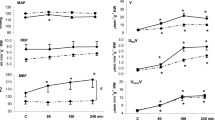Summary
The hemodynamic and neurohumoral effects of a single oral dose (0.4 mg) of the novel centrally acting antihypertensive agent moxonidine were investigated over 4 hours in ten patients with essential hypertension (WHO I-II). Pulmonary pressure indices and cardiac output were determined both at rest and during ergometric exercise by means of Swan-Ganz catheterization. Blood pressure was measured by sphygmomanometry and in the brachial artery. Moxonidine induced a significant fall in blood pressure over the 4-hour observation period from 176/105 mmHg to 158/95 mmHg (p<0.01), accompanied by a decrease in systemic vascular resistance from 1695 to 1427 dyn.sec/cm5 (p<0.01). Cardiac output remained unchanged, while heart rate increased slightly from 69 to 75 beats/min (p<0.01). No significant changes were recorded for either pulmonary artery pressure or pulmonary vascular resistance. Plasma levels of noradrenaline (337 vs. 224 pg/ml) and renin (2.6 vs 2.0 ng/ml/hr) activity fell significantly after moxonidine (p<0.05), both at rest and during exercise. Although aldosterone plasma levels fell slightly, levels of angiotensin II and ANF remained unchanged.
Moxonidine has favorable effects on hemodynamics and the neurohumoral system in patients with essential hypertension and is well tolerated at the dose administered.
Similar content being viewed by others
References
Armah IB. Contribution of presynaptic α2 adrenoceptor stimulation to the antihypertensive action of moxonidine. J Cardiovasc Pharmacol 1987;10(Suppl 4):581–583.
Armah IB, Hofferber E, Stenzel W. General pharmacology of the novel centrally acting antihypertensive agent moxonidine. Arzneimittelforschung/Drug Res 1988;38(II),10:1426–1434.
Armah IB. Unique presynaptic α2-receptor selectivity and specifity of the antihypertensive agent moxonidine. Arzneimittelforschung/Drug Res 1988;38(II),10:1435–1442.
Bergerhausen J. Moxonidine (BE 5895), a full agonist at human platelet α2 adrenoceptors. Naunyn-Schmiedeberg's Arch Pharmacol 1985;329(Suppl):R80.
Ernsberger P. Moxonidine, a second generation centrally-acting antihypertensive, binds selectively to imidazoline sites in the ventrolateral medulla (VLM) and kidney. Pharmacologist 1990;52:191.
Udvary E, Schäfer S, Vegh A, Szekeres L. Haemodynamic effects of moxonidine and clonidine. J. Mol Cell Cardiol 1990;22(Suppl III):PW 53.
Plänitz V, Hoffmann K. First clinical data on moxonidine HCl for treatment of mild to moderate hypertension. Naunyn-Schmiedeberg's Arch Pharmacol 1983;324(Suppl): R79.
Frisk-Holmberg M, Plänitz V. A selective α1 adrenocptors agonist in arterial essential hypertension. Current Ther Res 1987;42(1):138–146.
Plänitz V. Comparison of moxonidine and clonidine HCl in treating patients with hypertension. J Clin Pharmacol 1987;27:46–51.
Kringe KP, Greb H, Bayha G, Kranich S, Mitrovic V. HPLC-routine-analytik vonfreiem noradrenalin und adrenalin LABO-Fachzeitschrift für Labortechik 1986;17:7–12.
Haering N, Salama ZB. Determination of moxonidine in human plasma by gas chromatography/mass spectrometry with negative ion chemical ionization. LAB Report, March 1989, No. 88113.
Paran E, Lowenthal DT. Centrally acting sympatholytic agents in the treatment of hypertension. In: Drayer JIM, Lowenthal DT, Weber MA, eds. Drug therapy in hypertension. New York: 1987:109–123.
Brest AN. Hemodynamic and cardiac effects of clonidine. J Cardiovasc Pharmacol 1980;2(Suppl 1):39–46.
Frisk-Holmberg M, Paalzow L, Wibell L. Relationship between the cardiovascular effects and steady-state kinetics of clonidine in hypertension. Eur J Pharmacol 1984;26:309–313.
Ernsberger P, personal communication.
Kaplan NM. Clinical hypertension, 4th ed. Baltimore: Williams & Wilkins, 1986:238.
Corea L, Miele N, Bentivoglio M, et al. Acute and chronic effects of nifedipine on plasma renin activity and plasma adrenaline and noradrenaline in controls and hypertensive patients. Clin Sci 1979;57(Suppl 5):115–117.
Grimm RHJr. 972–5 in the treatment of hypertension. Hypertension 1989;13(Suppl 1):131–136.
Hutt HJ, Plänitz V. Pharmacodynamic action and plasma levels of moxonidine after single oral administration in hypertensive patients. Naunyn-Schmiedeberg's Arch Pharmacol 1986;332(Suppl):R98.
Strauer BE. The influence of sympathetic nervous activity on regression of cardiac hypertrophy. J Hypertens 1985;3(Suppl 4):939–944.
Timio M, Venanzi S, Gentili S, et al. Reversal of left ventricular hypertrophy after one-year treatment with clonidine: Relationship between echocardiographic findings, blood pressure, and urinary catecholamines. J Cardiovasc Pharmacol 1987;10(Suppl 12):S142-S146.
Fouad FM, Nakashima Y, Tarazi RC, Salcedo EE. Reversal of left ventricular hypertrophy in hypertensive patients treated with methyldopa. Lack of association with blood pressure control. Am J Cardiol 1982;49:795–801.
Author information
Authors and Affiliations
Rights and permissions
About this article
Cite this article
Mitrovic, V., Patyna, W., Hüting, J. et al. Hemodynamic and neurohumoral effects of moxonidine in patients with essential hypertension. Cardiovasc Drug Ther 5, 967–972 (1991). https://doi.org/10.1007/BF00143521
Issue Date:
DOI: https://doi.org/10.1007/BF00143521




